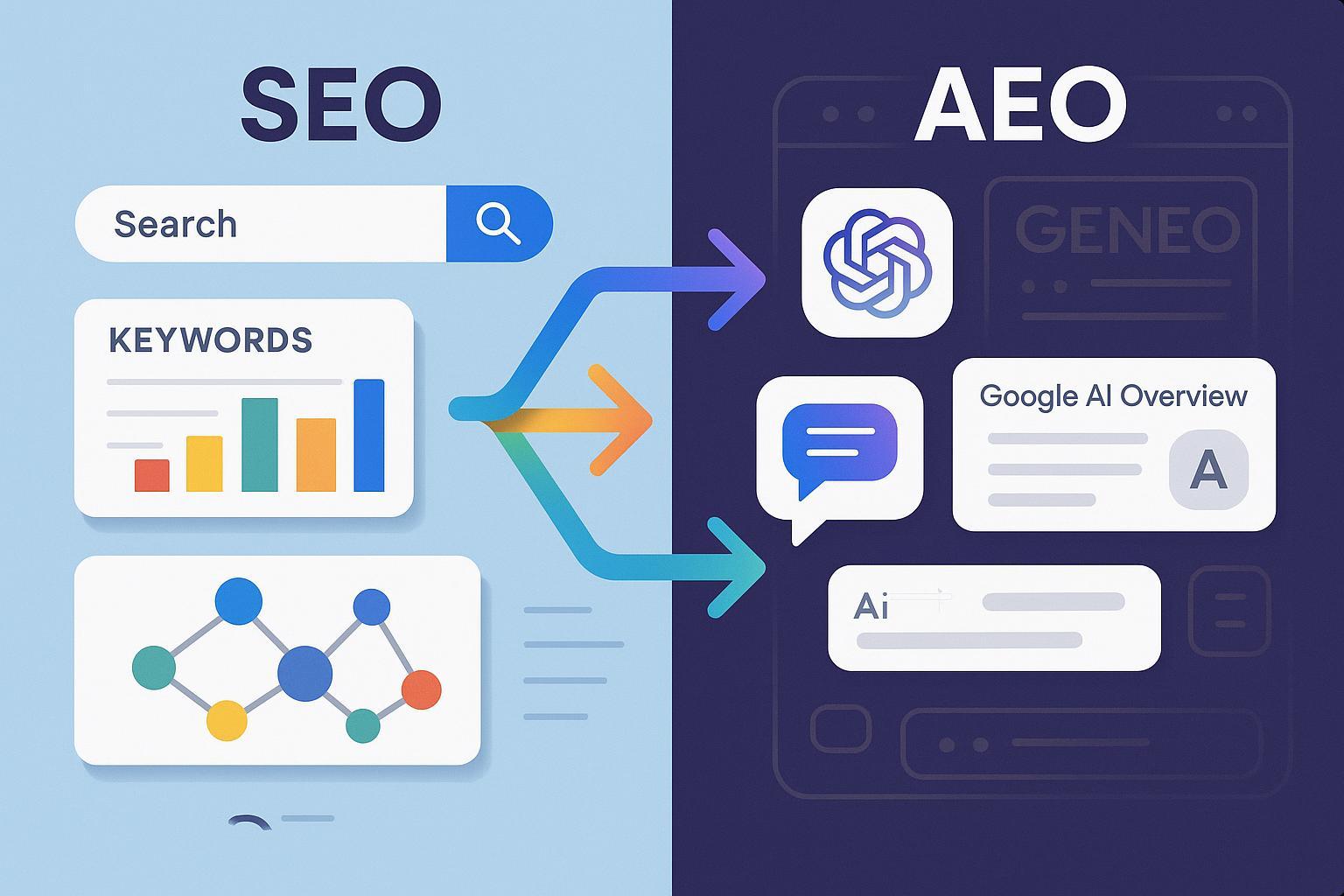AEO vs GEO: AI Search Metrics, Success Factors & Brand Measurement Guide
Compare AEO and GEO for brand visibility in the AI search era. Side-by-side metrics, new measurement KPIs, and why Geneo leads for AI answer engine optimization.


Introduction: The Search Revolution Every Brand Must Face
Digital visibility is undergoing a seismic shift. Generative AI engines like ChatGPT, Perplexity, and Google AI Overview are no longer just afterthoughts—they’re now dictating how consumers discover brands, products, and answers. The era of Google Engine Optimization (GEO, i.e., traditional SEO) determined by web rankings, clicks, and static search results is evolving. Welcome to the world of AI Engine Optimization (AEO), where success means being cited, positively represented, and repeatedly featured in AI-generated answers. The catch? Legacy SEO metrics can no longer tell you if you’re winning.
For marketers, brand leaders, and digital strategists, the question isn’t just “What works?” It’s “How do we measure success in AI search—and what tools bridge the visibility gap?”
What Is AEO vs GEO (Traditional SEO)?
GEO (Google Engine Optimization/Traditional SEO):
- Goal: Optimize web content to climb deterministic rankings on search engine results pages (SERPs).
- How: Focuses on keywords, backlinks, structured data, Core Web Vitals, and site authority.
- Core Metrics: Organic ranking, web traffic, CTR, conversions.
AEO (AI Engine Optimization):
- Goal: Optimize for answer inclusion and positive brand presence within generative AI outputs (e.g., ChatGPT, Perplexity, Google AI Overview).
- How: Relies on AI prompt coverage, context engineering, entity prominence, sentiment, and answer frequency — often across multiple AI platforms.
- Core Metrics: Brand mentions in AI answers, sentiment, frequency of inclusion, cross-platform visibility.
Learn more: Digiday - What are GEO and AEO and how do they differ from SEO?
1. Ranking Algorithms & Visibility Mechanisms
| Criteria | GEO (Traditional SEO) | AEO (AI Engine Optimization) |
|---|---|---|
| System | Deterministic, page-based | Probabilistic, answer/context-based |
| How It Ranks | Keyword relevance, backlinks, page factors, core vitals | LLM retrieval, context modeling, brand/entity prominence |
| Visibility Outcome | Fixed rank positions (SERPs) | Variable inclusion in AI answers; prominence/sentiment |
| Key Platforms | Google Search, Bing, Yahoo | ChatGPT, Perplexity, Google AI Overview, Claude |
- Takeaway:
- GEO rewards technical and content optimization for web page ranking.
- AEO determines visibility based on how and where your brand appears in AI-generated conversations and answers. No two users see identical results.
Authoritative source: Search Engine Land – How AI is reshaping SEO
2. Measurement & Success Metrics: The Evolution of KPIs
Legacy GEO/SEO Metrics
- Organic Ranking (SERP position)
- Organic Traffic (visits from search)
- Click-Through Rate (CTR)
- Conversion Rate
- Backlink Volume & Quality
AEO-Specific Metrics
- Brand Mention Frequency (across AI answers)
- Sentiment in AI Outputs (positive/neutral/negative)
- Answer Inclusion Rate (how often you appear in multi-engine answers)
- Prompt/Query Coverage (breadth across trending and brand-relevant topics)
- Visibility Trend by Engine (are you gaining or losing footing per platform?)
📊 Comparison Table: Key Metrics
| KPI | GEO/SEO | AEO |
|---|---|---|
| Ranking Position | Direct (SERPs) | Not applicable |
| Organic Traffic | Yes | Indirect |
| CTR | Yes | N/A in AI context |
| Brand Mentions in Answers | No | Yes (core metric) |
| Sentiment Score | Limited (reviews) | Yes (all AI-generated mentions) |
| Multi-Platform Coverage | No | Yes |
| AI Answer Presence | No | Yes |
| Competitor Visibility | Yes (limited) | Yes (cross-AI benchmarking) |
Why the change?
- AI search “results” aren’t universal or ranked—they’re dynamically generated, context-aware, and summarize multiple sources.
- Success now means being cited as an authority, referenced favorably, and mentioned frequently within diverse AI answers.
- Further reading: SEO vs. AEO & GEO – Why new measures matter (LinkedIn)
3. Optimization Strategies: What Actually Works?
| Aspect | GEO (SEO) | AEO (AI Optimization) |
|---|---|---|
| Keyword Research | Critical | Secondary (entity/context more vital) |
| Content Optimization | Long-form, keyword-rich | Focused, concise, entity-rich |
| Technical SEO | Essential (speed, schema) | Important (for source, less for AI) |
| Backlink Building | Highly impactful | Indirect effect (AI sometimes cites) |
| Prompt/Entity Engineering | N/A | Core technique |
| Multi-Platform Structure | Rarely considered | Essential (AI answers draw from many) |
- AEO tactics include “prompt stacking,” entity optimization, and ensuring brand-relevant answers exist and are positively formulated for AI retrieval.
- GEO/SEO focuses more on page visibility, while AEO requires multi-platform AI presence engineering and measuring answer frequency, sentiment, and context.
4. Brand Management & Marketing Impact
Traditional SEO (GEO):
- Brand management means carefully curating your top web pages for high-intent keywords and protecting reputation with review and site content.
- Campaigns aim to drive traffic, generate leads, and convert visits, rooted in Google Analytics data.
AI Era (AEO):
- Brand management now requires monitoring not just web presence—but how brands are depicted in AI-generated answers, their sentiment, and prominence.
- Campaigns strive for brand inclusion in authoritative answers across ChatGPT/Perplexity/Google AI, with proactive “answer optimization.”
- Pilot data: Brands shifting ~30% of measurement to AEO (instead of pure SEO) saw up to 30% increase in AI-source brand inquiries (2024 SaaS pilots).
- Use case: An ecommerce brand using Geneo tracked spikes in AI shopping recommendations, leading to higher direct AI-driven product discovery.
5. Data Transparency & Actionability
| Category | GEO/SEO: Tools & Access | AEO: Tools & Access |
|---|---|---|
| Analytics Source | Google Analytics, Search Console | Multi-engine AI visibility trackers (e.g., Geneo) |
| Exportability | Robust, standard reports | Varies; new tools now offer batch export, time-series, and sentiment breakdowns |
| Benchmarking | Deep historical baseline data | Emerging trend; competitive benchmarking by answer/sentiment is now possible |
| Weaknesses | Clear for web; blind to AI answers | Rapidly evolving data standards, less universal visibility |
Key point: Modern AEO tools like Geneo are closing the transparency gap, enabling brands to see real-time and historical answer presence, sentiment, and cross-platform trends that GEO/SEO tools can’t reach.
6. [Table] AEO vs GEO/SEO: Complete KPI & Measurement Summary
| Dimension / KPI | GEO/SEO | AEO (AI Engine Optimization) |
|---|---|---|
| Primary Visibility Metric | SERP Rank, Traffic, CTR | Answer Inclusion, Sentiment, Mentions |
| Sentiment Analytics | Reviews, News, Social | All AI answer outputs, real-time |
| Tracking Platforms | Google, Bing, Yahoo, SEMrush | ChatGPT, Perplexity, Google AI, Claude |
| Brand/Competitor Benchmarking | Yes (web only) | Yes (full AI cross-platform) |
| Data Export & Analytics | Robust, standard | Actionable, platform-specific |
| Optimization Cycle | Site/content monthly cycle | Continuous, multi-platform, answer-centric |
| Example Tool | SEMrush, Ahrefs, Moz | Geneo, Goodie AI, Profound |
7. How Geneo Powers Modern Brand Measurement in AEO
Geneo (geneo.app) is the first AEO-native visibility and sentiment tracking platform built from the ground up for competitive brands in the AI era:
- Multi-platform AI monitoring: Track brand presence simultaneously across ChatGPT, Google AI Overview, Perplexity, Claude, and more.
- AI answer inclusion benchmarking: See where, how often, and in what context your brand is referenced.
- Sentiment analytics: Understand positive/negative/neutral tone across all AI-generated outputs.
- Historical answer log: Audit how answer coverage shifts by topic and over time—enabling proactive content strategy.
- Content optimization roadmap: Identify exactly what to improve for higher AI answer inclusion.
- Affordable, scalable pricing: Free tier for 1 brand; Pro ($39.90/month), and fully customizable enterprise plans.
- Multi-brand/team support: Manage and optimize visibility for multiple brands or business units in a single workspace.
User Feedback Highlight:
“Geneo lets our team see, for the first time, where and how our brand is referenced in live AI answers. The sentiment and answer history features are especially useful. Setup was quick and the license is practical for both single and multi-brand teams.”
Practical Workflow using Geneo:
- Set up brand(s), keywords, and competitor tracking.
- Monitor real-time and weekly AI answer inclusion and sentiment scores.
- Review prompt/response history for gaps and opportunities.
- Get monthly content optimization recommendations engineered for AI answer engines.
- Export and benchmark trendlines for actionable reporting.
Dive deeper: Geneo’s official feature overview
Recommendations: The Modern Brand Measurement Roadmap
- Acknowledge the paradigm shift: Classic SEO metrics are no longer reliable proxies for overall digital visibility.
- Expand measurement: Track brand presence, sentiment, and answer inclusion across AI engines—not just web rankings.
- Adopt multi-platform monitoring: Use tools built for the AI search age (like Geneo) to benchmark, react, and win visibility wherever answers are generated.
- Iterate strategy: Blend the best of GEO and AEO; optimize web quality for legacy search, but proactively engineer for AI answer inclusion and authority.
Conclusion
Brands and marketers who evolve their measurement practices now—embracing both AI-native metrics and the actionable transparency delivered by new AEO platforms—will own the next wave of digital discoverability.
Ready to see how your brand appears in ChatGPT, Perplexity, and Google AI Overview?
👉 Explore Geneo’s free trial and transform your AI search visibility here.





